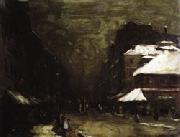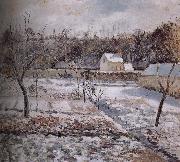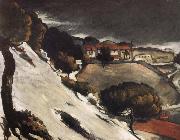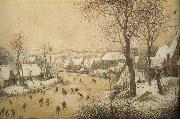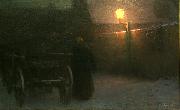Wholesale Oil Painting No Minimum |
|||||||||||
|
|
|||||||||||

|
|||||||||||
|
|
|
||||||||
Robert Henri1865-1929 Robert Henri was born Robert Henry Cozad in Miami, Florida to Theresa Gatewood Cozad of Malden, Virginia and John Jackson Cozad, a gambler and real estate developer. Henri had a brother, Johnny, and was a distant cousin of the noted American painter Mary Cassatt. In 1871, Henri's father founded the town of Cozaddale, Ohio. In 1873, the family moved west to Nebraska, where they founded the town of Cozad. In October 1882, Henri's father became embroiled in a dispute with a rancher, Alfred Pearson, over the right to pasture cattle on land claimed by the family. When the dispute turned physical, Cozad shot Pearson fatally with a pistol. Cozad was eventually cleared of wrongdoing, but the mood of the town turned against him. He fled to Denver, Colorado, and the rest of the family followed shortly. In order to disassociate themselves from the scandal, family members changed their names. The father became known as Richard Henry Lee, and his sons posed as adopted children under the names Frank Southern and Robert Earl Henri (pronounced "hen rye"). In 1883, the family moved to New York City, then to Atlantic City, New Jersey, where the young artist completed his first paintings. |
||||||||
|
|
||||||||
Snow
Snow Painting ID:: 11800 |
1899(Salon de la Societe nationale des Beaux-Arts,1899) 1899(Salon de la Societe nationale des Beaux-Arts,1899) |
|||||||
|
|
||||||||
Camille PissarroCaribbean-born French Pointillist/Impressionist Painter, ca.1830-1903 .Painter and printmaker. He was the only painter to exhibit in all eight of the Impressionist exhibitions held between 1874 and 1886, and he is often regarded as the 'father' of the movement. He was by no means narrow in outlook, however, and throughout his life remained as radical in artistic matters as he was in politics. Thad?e Natanson wrote in 1948: 'Nothing of novelty or of excellence appeared that Pissarro had not been among the first, if not the very first, to discern and to defend.' The significance of Pissarro's work is in the balance maintained between tradition and the avant-garde. Octave Mirbeau commented: 'M. Camille Pissarro has shown himself to be a revolutionary by renewing the art of painting in a purely working sense; |
||||||||
|
|
||||||||
|
|
Snow
Snow Painting ID:: 57848 |
mk259 1882 Oil on canvas years 46 x 55 cm mk259 1882 Oil on canvas years 46 x 55 cm |
||||||
|
|
||||||||
Camille PissarroCaribbean-born French Pointillist/Impressionist Painter, ca.1830-1903 .Painter and printmaker. He was the only painter to exhibit in all eight of the Impressionist exhibitions held between 1874 and 1886, and he is often regarded as the 'father' of the movement. He was by no means narrow in outlook, however, and throughout his life remained as radical in artistic matters as he was in politics. Thad?e Natanson wrote in 1948: 'Nothing of novelty or of excellence appeared that Pissarro had not been among the first, if not the very first, to discern and to defend.' The significance of Pissarro's work is in the balance maintained between tradition and the avant-garde. Octave Mirbeau commented: 'M. Camille Pissarro has shown himself to be a revolutionary by renewing the art of painting in a purely working sense; |
||||||||
|
|
||||||||
|
|
Snow
Snow Painting ID:: 60596 |
mk259 1874 Oil on canvas 54 x 64.8 cm mk259 1874 Oil on canvas 54 x 64.8 cm |
||||||
|
|
||||||||
Paul CezanneFrench Post-Impressionist Painter, 1839-1906 During the second half of the 19th century French impressionism created a dramatic break with the art of the past. In conception and appearance the style was radically new and, although it initially inspired public ridicule, it soon affected nearly every ambitious artist in western Europe. The new vision emerged during the 1870s, chiefly in the art of Claude Monet, Auguste Renoir, and Camille Pissarro. For each of these artists impressionism was an illusionistic style which differed from the tradition of Renaissance illusionism in its greater emphasis upon vibrant, natural color and on an immediate confrontation with the phenomena of the visible world. As the style developed during the 1880s, however, it increasingly became characterized by paintings which were flat rather than illusionistic. In other words, the impressionists insistence upon a direct application of pigment to canvas resulted in surfaces which declared themselves first of all as surfaces - and, consequently, in paintings which declared themselves first of all as paintings rather than as windows which looked out upon the natural world. The tendency toward flatness persisted into the last years of the 19th century, its pervasiveness giving the impression that illusionistic space - fought for, won, and defended since the very beginning of the Renaissance - had finally been sacrificed by the medium of painting. Paul C??zanne worked within and finally emerged from this trend. As a painter, he matured slowly, his greatest works coming during the last 25 years of his life. During this period he scored a remarkable and heroic achievement: he restored to painting the space and volume that had seemingly been lost to it. But he did it in a totally unprecedented way: not by return to the illusionism of the past but by the creation of a spatial illusionism that did not violate flatness. C??zanne was born on Jan. 19, 1839, in Aix-en-Provence. His father, Philippe Auguste, was the cofounder of a banking firm which prospered throughout the artist life, affording him financial security that was unavailable to most of his contemporaries and eventually resulting in a large inheritance. In 1852 C??zanne entered the Coll??ge Bourbon, where he met and became friends with Émile Zola. This friendship was decisive for both men: with youthful romanticism they envisioned successful careers in the Paris art world, C??zanne as a painter and Zola as a writer. Consequently, C??zanne began to study painting and drawing at the École des Beaux-Arts in Aix in 1856. His father opposed the pursuit of an artistic career, and in 1858 he persuaded C??zanne to enter law school at the University of Aix. Although C??zanne continued his law studies for several years, he was simultaneously enrolled in the School of Design in Aix, where he remained until 1861. In 1861 C??zanne finally convinced his father to allow him to go to Paris. He planned to join Zola there and to enroll in the École des Beaux-Arts. But his application was rejected and, although he had gained inspiration from visits to the Louvre, particularly from the study of Diego Vel??zquez and Caravaggio, C??zanne experienced self-doubt and returned to Aix within the year. He entered his father banking house but continued to study at the School of Design. The remainder of the decade was a period of flux and uncertainty for C??zanne. His attempt to work in his father business was abortive, and he returned to Paris in 1862 and stayed for a year and a half. During this period he met Monet and Pissarro and became acquainted with the revolutionary work of Gustave Courbet and Édouard Manet. C??zanne also admired the fiery romanticism of Eug??ne Delacroix paintings. But he was never entirely comfortable with Parisian life and periodically returned to Aix, where he could work in relative isolation. He retreated there, for instance, during the Franco-Prussian War (1870-1871). |
||||||||
|
|
||||||||
|
|
snow
snow Painting ID:: 60808 |
mk273 1871 Oil on canvas 72.5 x 92 cm mk273 1871 Oil on canvas 72.5 x 92 cm |
||||||
|
|
||||||||
Pieter Bruegelc.1525-69 Greatest Netherlandish painter of the 16th century. Not much is known of his early life, but in 1551 he set off for Italy, where he produced his earliest signed painting, Landscape with Christ and the Apostles at the Sea of Tiberias (c. 1553). Returning to Flanders in 1555, he achieved some fame with a series of satirical, moralizing prints in the style of Hiëronymus Bosch, commissioned by an Antwerp engraver. He is best known for his paintings of Netherlandish proverbs, seasonal landscapes, and realistic views of peasant life and folklore, but he also took a novel approach to religious subject matter, portraying biblical events in panoramic scenes, often viewed from above. He had many important patrons; most of his paintings were commissioned by collectors. In addition to many drawings and engravings, about 40 authenticated paintings from his enormous output have survived. |
||||||||
|
|
||||||||
|
|
Snow
Snow Painting ID:: 61929 |
mk277 1565 Oil Painting 37 x 55.5cm wood mk277 1565 Oil Painting 37 x 55.5cm wood |
||||||
|
|
||||||||
Jakub Schikaneder(February 27, 1855, Prague - November 15, 1924, Prague) was a Czech painter, known for his soft paintings of the outdoors, often lonely in mood. The National Gallery in Prague held an exhibition of his paintings from May 1998 until January 1999. He was descended from Urban Schikaneder, the elder brother of the librettist Emanuel Schikaneder. |
||||||||
|
|
||||||||
|
|
Snow
Snow Painting ID:: 86451 |
1899(1899)
Medium Oil on canvas
Dimensions 116 x 181 cm (45.7 x 71.3 in)
cyf 1899(1899) Medium Oil on canvas Dimensions 116 x 181 cm (45.7 x 71.3 in) cyf |
||||||
|
|
||||||||
|
Jakub Schikaneder (February 27, 1855, Prague - November 15, 1924, Prague) was a Czech painter, known for his soft paintings of the outdoors, often lonely in mood. The National Gallery in Prague held an exhibition of his paintings from May 1998 until January 1999. He was descended from Urban Schikaneder, the elder brother of the librettist Emanuel Schikaneder. Snow 1899(1899) Medium Oil on canvas Dimensions 116 x 181 cm (45.7 x 71.3 in) cyf |
||||||||
|
|
||||||||
|
Prev Next
|
||||||||
|
|
||||||||
|
Related Paintings to Jakub Schikaneder :. |
||||||||
|
|
||||||||
|
CONTACT US |
